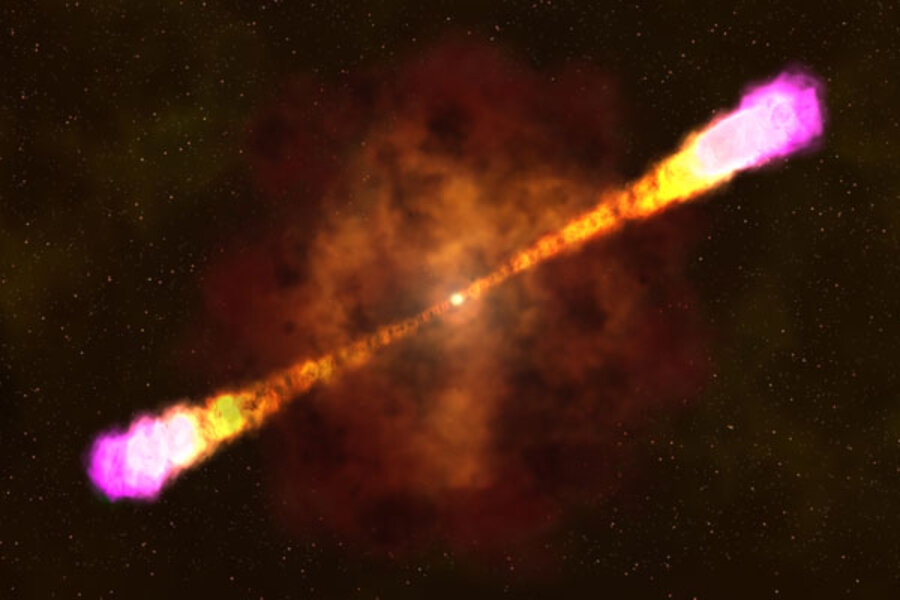Scientists witness massive gamma-ray burst, don't understand it
Loading...
An exploded star some 3.8 billion light-years away is forcing scientists to overhaul much of what they thought they knew about gamma-ray bursts – intense blasts of radiation triggered, in this case, by a star tens of times more massive than the sun that exhausted its nuclear fuel, exploded, then collapsed to form a black hole.
Last April, gamma rays from the blast struck detectors in gamma-ray observatories orbiting Earth, triggering a frenzy of space- and ground-based observations. Many of them fly in the face of explanations researchers have developed during the past 30 years for the processes driving the evolution of a burst from flash to fade out, according to four research papers appearing Friday in the journal Science.
“Some of our theories are just going down the drain,” said Charles Dermer, an astrophysicist at the Los Alamos National Laboratory in New Mexico and a member of one of the teams reporting on their observations of the burst, known as GRB 130427A.
The event, dubbed a long-duration gamma-ray burst (GRB), is typically seen in the distant, early universe, Dr. Dermer said during a briefing Thursday. This one was much closer. And while typical long-duration bursts last from a few seconds to a few minutes, GRB 130427A put on its display for 20 hours.
The event's duration, relatively close proximity, and the range of observatories in space and on the ground that could monitor it at a range of wavelengths has provided scientists with an unprecedented opportunity to explore the workings of one of the more extreme ends a star can inflict on itself.
The encouraging news: Traits seen in the gamma-ray emissions from initial burst through the afterglow compare favorably to the traits seen in the behavior of gamma rays in more-distant, long-duration bursts.
“This suggests that GRBs in the contemporary universe and in the early, distant universe share a common central engine,” Dermer said.
In October, a team led by Dong Xu, an astrophysicist at the University of Copehagen, found evidence for a stellar explosion, or supernova, at GRB 130427A's location. The evidence pointed to a type of supernova that involves a star with at least 20 to 30 times the sun's mass.
Such stars are so large than when they finally collapse, they form black holes. In the process of collapsing, the black hole sends jets of electrons and ionized gas spiraling out along along magnetic fields forming near the black hole's poles.
These jets punch their way through the turbulent, expanding layers of material the star shed in the explosion and its prelude. And they collide with the interstellar medium – the dust and gas between stars. Collisions inside and outside the expanding layer can generate gamma rays, which tend to be focused in the direction the jets point. This makes the object an extremely bright gamma-ray beacon, if briefly, when the viewing angle is just right.
Indeed, GRB 130427A “topped the charts” in the amount of gamma-ray photons it released, the energy levels some of those photons achieved, total explosion energy, and its gamma-ray brilliance, added Paul Hertz, who heads NASA's astrophysics division in Washington. At visible wavelengths, the burst was the second brightest GRB researchers have seen.
That made possible the detailed measurements that have left researchers scratching their chins.
For instance, ordinarily, one might expect the gamma-ray photons with the highest energy to appear immediately following the star's explosion, researchers say. But with GRB 130427A, some of the highest energy photons, including the new record-holder, appeared hours after the blast.
“This is hard to explain with our current models,” Dermer said.
In addition, gamma rays and emissions at visible wavelengths brightened and dimmed in tandem, quite unexpected because theory suggested they come from different regions of the expanding shells of material and thus should have peaked and dimmed at different times.
Finally, theorists had posited different mechanisms for generating gamma rays and X-rays that are part of the light show a long-duration gamma-ray burst puts on. The result should have been a fadeout for the two forms of light punctuated by periods where emissions were interrupted. Instead, the two dimmed smoothly.
The theoretical edifice GRB 130427A is eroding has been 46 years in the making.
Scientists stumbled across the first gamma-ray burst in 1967, when a US satellite designed to detect nuclear-weapons tests in space picked up a burst's emissions. As follow-on versions of the satellite with better sensors were lofted, scientists detected more. By 1973, the data were declassified and published, opening a window on the mysterious phenomenon.
It took another 18 years to determine that the bursts they were seeing occurred far outside the Milky Way, where researchers originally thought the bursts were taking place.








